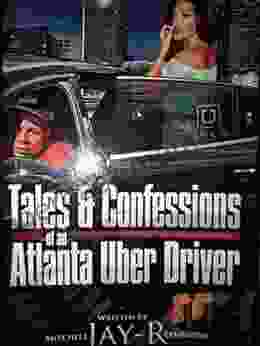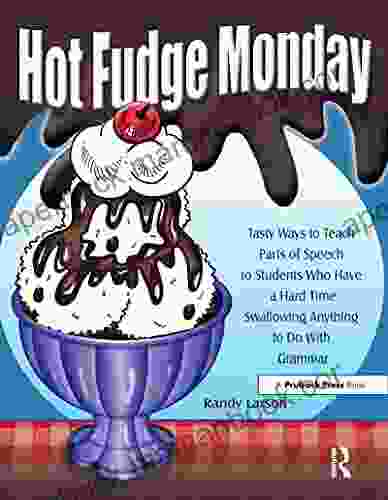Tasty Ways to Teach Parts of Speech to Students Who Have a Hard Time Swallowing

Parts of speech are the building blocks of language. They help us to understand the meaning of words and sentences. However, for students with learning challenges, understanding parts of speech can be a difficult task. Traditional methods of teaching parts of speech, such as lectures and worksheets, may not be effective for these students.
5 out of 5
| Language | : | English |
| File size | : | 3297 KB |
| Text-to-Speech | : | Enabled |
| Enhanced typesetting | : | Enabled |
| Word Wise | : | Enabled |
| Print length | : | 366 pages |
| Screen Reader | : | Supported |
This article provides educators with engaging and practical strategies for teaching parts of speech to students with learning challenges. The focus is on using multisensory and hands-on activities to make the learning process more accessible and enjoyable.
Multisensory Activities
Multisensory activities engage multiple senses to help students learn. This can be especially beneficial for students with learning challenges, who may have difficulty processing information through traditional methods.
Here are some multisensory activities that can be used to teach parts of speech:
- Touch and Feel: Have students touch and feel different objects in the classroom. Ask them to identify the parts of speech of the words that describe the objects.
- Sound and Movement: Have students create sound effects for different parts of speech. For example, they could clap their hands for nouns, stomp their feet for verbs, and snap their fingers for adjectives.
- Smell and Taste: Have students smell and taste different foods. Ask them to identify the parts of speech of the words that describe the foods.
Hands-On Activities
Hands-on activities allow students to learn by ng. This can be especially helpful for students with learning challenges, who may need more concrete experiences to understand concepts.
Here are some hands-on activities that can be used to teach parts of speech:
- Sorting Activities: Have students sort words into different categories based on their parts of speech. For example, they could sort words into nouns, verbs, adjectives, and adverbs.
- Sentence Building: Have students create sentences using different parts of speech. For example, they could create a sentence using a noun, a verb, and an adjective.
- Role-Playing: Have students role-play different parts of speech. For example, they could role-play a noun, a verb, or an adjective.
Differentiated Instruction
Differentiated instruction is a teaching approach that tailors instruction to the individual needs of students. This can be especially important for students with learning challenges, who may need different levels of support and accommodations.
Here are some ways to differentiate instruction when teaching parts of speech to students with learning challenges:
- Provide visual supports: Use charts, diagrams, and other visual aids to help students understand parts of speech.
- Offer multiple representations: Present information in different ways, such as through text, audio, and video.
- Allow for flexible pacing: Give students the time and support they need to learn at their own pace.
- Provide ongoing feedback: Regularly assess students' understanding of parts of speech and provide feedback to help them improve.
Teaching parts of speech to students with learning challenges can be a challenge. However, by using multisensory and hands-on activities, and by differentiating instruction, educators can make the learning process more accessible and enjoyable. With the right strategies, all students can learn to understand and use parts of speech.
5 out of 5
| Language | : | English |
| File size | : | 3297 KB |
| Text-to-Speech | : | Enabled |
| Enhanced typesetting | : | Enabled |
| Word Wise | : | Enabled |
| Print length | : | 366 pages |
| Screen Reader | : | Supported |
Do you want to contribute by writing guest posts on this blog?
Please contact us and send us a resume of previous articles that you have written.
 Top Book
Top Book Novel
Novel Fiction
Fiction Nonfiction
Nonfiction Literature
Literature Paperback
Paperback Hardcover
Hardcover E-book
E-book Audiobook
Audiobook Bestseller
Bestseller Classic
Classic Mystery
Mystery Thriller
Thriller Romance
Romance Fantasy
Fantasy Science Fiction
Science Fiction Biography
Biography Memoir
Memoir Autobiography
Autobiography Poetry
Poetry Drama
Drama Historical Fiction
Historical Fiction Self-help
Self-help Young Adult
Young Adult Childrens Books
Childrens Books Graphic Novel
Graphic Novel Anthology
Anthology Series
Series Encyclopedia
Encyclopedia Reference
Reference Guidebook
Guidebook Textbook
Textbook Workbook
Workbook Journal
Journal Diary
Diary Manuscript
Manuscript Folio
Folio Pulp Fiction
Pulp Fiction Short Stories
Short Stories Fairy Tales
Fairy Tales Fables
Fables Mythology
Mythology Philosophy
Philosophy Religion
Religion Spirituality
Spirituality Essays
Essays Critique
Critique Commentary
Commentary Glossary
Glossary Bibliography
Bibliography Index
Index Table of Contents
Table of Contents Preface
Preface Introduction
Introduction Foreword
Foreword Afterword
Afterword Appendices
Appendices Annotations
Annotations Footnotes
Footnotes Epilogue
Epilogue Prologue
Prologue James D Shipman
James D Shipman Tony Pereda
Tony Pereda Joseph Samachson
Joseph Samachson Kim Solga
Kim Solga Grace Fleming
Grace Fleming Brad Taylor
Brad Taylor Richard D Parsons
Richard D Parsons Jasmin Harsono
Jasmin Harsono Bob Hartman
Bob Hartman Olive Schreiner
Olive Schreiner Richard D Wolff
Richard D Wolff John Hagensen
John Hagensen Nick Roche
Nick Roche Sarah Woodbury
Sarah Woodbury Nina Du Thaler
Nina Du Thaler Sarah Wooley
Sarah Wooley Joanna Toye
Joanna Toye Ellis Morgan
Ellis Morgan Lisa Bodenburg
Lisa Bodenburg Mark Simmons
Mark Simmons
Light bulbAdvertise smarter! Our strategic ad space ensures maximum exposure. Reserve your spot today!

 Jacob FosterUnveiling the Enchanting Tales from the Brewstop: A Journey into the Realm of...
Jacob FosterUnveiling the Enchanting Tales from the Brewstop: A Journey into the Realm of... William FaulknerFollow ·10.4k
William FaulknerFollow ·10.4k Roy BellFollow ·19.8k
Roy BellFollow ·19.8k Hayden MitchellFollow ·17.3k
Hayden MitchellFollow ·17.3k Roberto BolañoFollow ·2.9k
Roberto BolañoFollow ·2.9k Gabriel HayesFollow ·16.6k
Gabriel HayesFollow ·16.6k Gage HayesFollow ·10.9k
Gage HayesFollow ·10.9k Braeden HayesFollow ·6.1k
Braeden HayesFollow ·6.1k Fernando BellFollow ·18.8k
Fernando BellFollow ·18.8k

 Jeremy Mitchell
Jeremy MitchellPlay We Now On Christmas Violin Christmas: A Heartfelt...
Play We Now On...

 Terry Bell
Terry BellTales from the Road: Confessions of an Atlanta Uber...
In the vibrant...

 Ervin Bell
Ervin BellThe French Admiral: A Gripping Naval Adventure with Alan...
In the vast expanse of...

 Henry David Thoreau
Henry David ThoreauCrochet Cozy Afghan Patterns: Crochet Weekend Afghan...
to Crochet...

 Orson Scott Card
Orson Scott CardAn Archaeological View Of The Industrialization Of North...
The industrialization of North America was a...

 Josh Carter
Josh CarterClipboard Christmas Skits by Tom Spence: A Festive...
A Christmas...
5 out of 5
| Language | : | English |
| File size | : | 3297 KB |
| Text-to-Speech | : | Enabled |
| Enhanced typesetting | : | Enabled |
| Word Wise | : | Enabled |
| Print length | : | 366 pages |
| Screen Reader | : | Supported |










